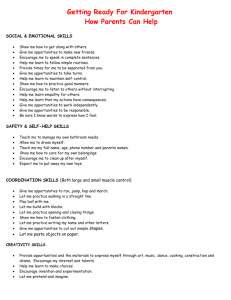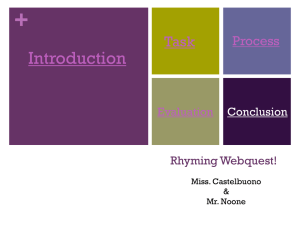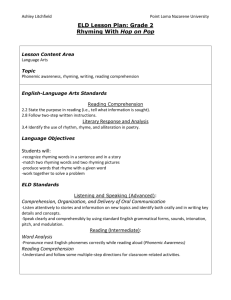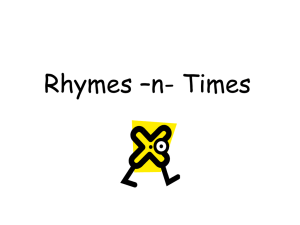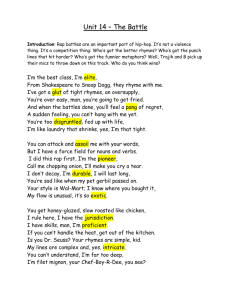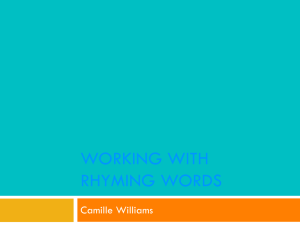Why Rhyming?
advertisement
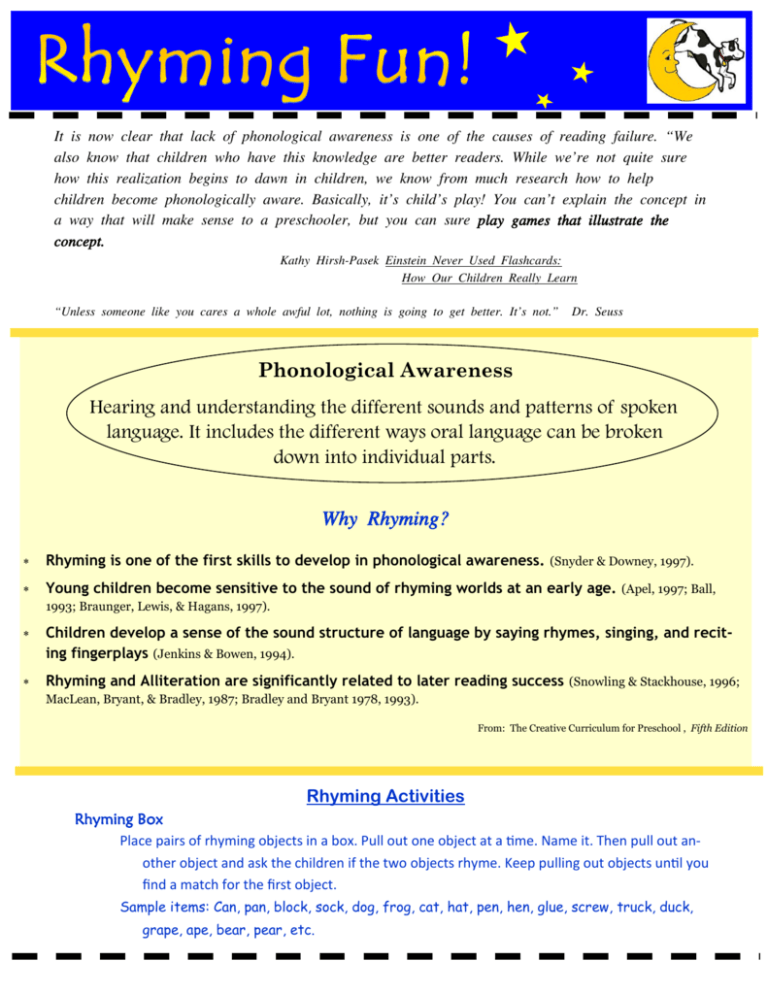
It is now clear that lack of phonological awareness is one of the causes of reading failure. “We also know that children who have this knowledge are better readers. While we’re not quite sure how this realization begins to dawn in children, we know from much research how to help children become phonologically aware. Basically, it’s child’s play! You can’t explain the concept in a way that will make sense to a preschooler, but you can sure play games that illustrate the concept. Kathy Hirsh-Pasek Einstein Never Used Flashcards: How Our Children Really Learn “Unless someone like you cares a whole awful lot, nothing is going to get better. It’s not.” Dr. Seuss Phonological Awareness Hearing and understanding the different sounds and patterns of spoken language. It includes the different ways oral language can be broken down into individual parts. Why Rhyming? Rhyming is one of the first skills to develop in phonological awareness. (Snyder & Downey, 1997). Young children become sensitive to the sound of rhyming worlds at an early age. (Apel, 1997; Ball, 1993; Braunger, Lewis, & Hagans, 1997). Children develop a sense of the sound structure of language by saying rhymes, singing, and reciting fingerplays (Jenkins & Bowen, 1994). Rhyming and Alliteration are significantly related to later reading success (Snowling & Stackhouse, 1996; MacLean, Bryant, & Bradley, 1987; Bradley and Bryant 1978, 1993). From: The Creative Curriculum for Preschool , Fifth Edition Rhyming Activities Rhyming Box Place pairs of rhyming objects in a box. Pull out one object at a time. Name it. Then pull out another object and ask the children if the two objects rhyme. Keep pulling out objects until you find a match for the first object. Sample items: Can, pan, block, sock, dog, frog, cat, hat, pen, hen, glue, screw, truck, duck, grape, ape, bear, pear, etc. Wacky Rhymes Choose a longer, funny word. Encourage the children to make up nonsense words that rhyme with it. “I Spy” Look around the room, pick something, and tell the children, “I Spy something that rhymes with „clock‟”. Encourage the children to come up with rhyming words for your chosen word. Jump Rhymes Engage the children in a movement activity like: “Let‟s jump whenever we say a work that rhymes with… For example: “HEAD” and when the children call out „bed!‟ everyone jumps. Then call out ‘led’ and jumps again. You could also hop or clap or spin around—just attach some sort of fun movement to the rhymes. This will make children want to keep rhyming. Name Game Sing the old song using the children’s names: Susan, Susan bo-boosin Banana fanna-fo-foosin Me my mo-moosin Susan Fingerplays, Rhymes and Poetry Libraries have books that are wonderful collections of fingerplays. You can also easily find appropriate rhymes by typing “subject fingerplays” into Google. For example: Pigs Fingerplays will get you many sites with fingerplays and rhymes about Pigs. Songs and Singing (See Song sheet) Tables Rhyming Toss Call out a word and toss a ball to a child. Encourage them to call out a rhyming word (or nonsense word) before tossing the ball to another child. Keep tossing the ball until the group runs out of words, or until a new word seems needed. Rhyming File Pockets – Paste pictures of objects on file folders or manila envelopes. Cut out smaller photos of objects that rhyme with the larger photos. Spread the small photos on a table and encourage the children to put the small photos into the envelopes with the objects with which they rhyme. Rhyming Memory Show the children the photos on each of the cards to inform them of all the objects. Shuffle the cards and place them face down on a table. Each player turns over two cards at a time. If the cards rhyme, the player removes them from table and keeps them and takes another turn until they do not turn over a rhyming pair. For younger children—leave the cards face up and look for rhyming pairs. Hink Pinks (School-age) Put the questions out for the children to read (or recite them) Write or print the answers on the back side of the questions. Say this to a Female Deer to make her leave (Go/Doe) 24 hours with toys (Play/Day) 50% giggle (Half/Laugh) A birds foot defect (Claw/Flaw) A blue-green moray (teal/Eel) A boring Choo-choo (Plain/Train) A boy slug with a shell (Male/Snail) A cap that got sat on (Flat/Hat) A cloudy 24 hours (Gray/day) A contest for who ties their shoes the fastest (Lace/race) A daring removal of hair from the face (Brave/Shave) A farm house used to store the favorite string (Barn/Yarn) A feathered animals droppings (Bird/Turd) A fragile end of the finger (Frail/Nail) A keen eyed bird's discussion (Hawk/Talk) A large branch (Big/Twig) A hilarious rabbit (Funny/Bunny) A plate of tuna? ( Fish/Dish) A small pollinator? (Wee/Bee) Where do you put a criminal orca? (Whale/Jail) For MANY more Hink Pinks: http://www.wuzzlesandpuzzles.com/hinkpinks/ Rhyming Flannelboards Place an item on the flannel board and have the children name things that rhyme with that item. Here are a couple of ideas for Rhyming Flannels: 1 2 3 Bun Shoe Bee Sun Screw Tree Act Out Nursery Rhymes A wonderful and entertaining way to introduce children to old Mother Goose rhymes. (A sample booklist of Mother Goose Collections is attached.) What‟s the Color that Rhymes With ? Place color felt squares up on the wall, or on a table Sing this song: (Mary Had a Little Lamb tune) What’s the Color that Rhymes with Rhymes with ? Rhymes with ? What’s the Color that Rhymes with Can you say its name? ? ? Ask the children—”What color rhymes with Sample rhyming words: Head/Red, Bean/Green, Mellow/Yellow, True/Blue etc. ? Rhyming Chains Glue or tape a photograph of an object or thing onto a strip of paper. Tape or staple that strip into the first circle of a chain. Using photos or drawings or written words, glue or write rhyming objects onto strips of paper and attach them to the first link. Compare which words have more rhyming links than others. Use these to decorate your room. Rhyming Books Paste a photo on the top of a piece of paper. Encourage the children to draw items that rhyme with the item in the photo. Write rhyming words as well or use cut out photos. Or use the Rhyming Book template to create individual booklets. Rhyming Bingo Designate one person as the “reader”. The other players select a card with images on it. The reader pulls one word at a time out of the bag and reads it aloud and encourages the players to see if they have an image on their card that rhymes with the word that was just read aloud. If they have a rhyming image, they cover it with a circle. When a player gets three circles in a row, they say BINGO! Rhyming Musical Chairs Tape photographs of objects onto chairs or the floor. Play music and when the music stops, everyone sits or stands on a photo. Taking turns each child names the object in the photo and then comes up with a word that rhymes with it. Rhyming Spinners Show the children the spinner and then spin it. Call out the name of the object on which the arrow point lands. Ask the children to call out words that rhyme with that object. Spin again. If you like, create a chart and write the rhyming words beneath the object’s name. Rhyming Picture Books (See attached Book list) Rhyming Books Chart Create a Rhyming Word chart. Every time you read a rhyming book, read it a second time and encourage the children to count the number of rhymes in the book. Keep track of which books had the most and least rhymes. Susan Anderson-Newham Early Learning Supervising Librarian Pierce County Library System (253) 548-3424 susana@piercecountylibrary.org
